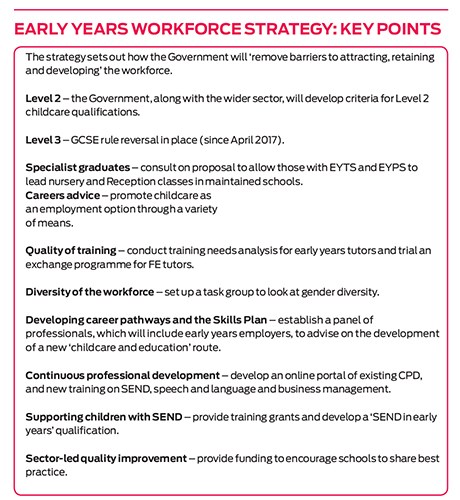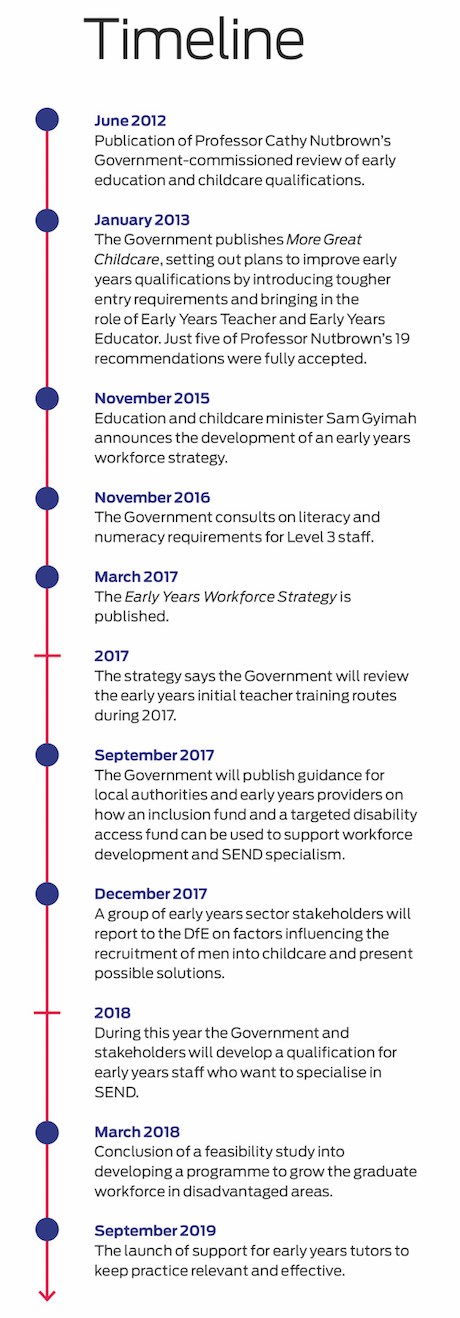Training Today: Workforce Strategy - Will it work?
Hannah Crown
Monday, July 10, 2017
The long-awaited workforce strategy needs to tackle staff recruitment, retention and underpin quality provision. Is it the blueprint the sector needs? asks Charlotte Goddard

Download the pdf here
When the early years workforce strategy was finally released on 3 March, 14 months after it was first announced, it was greeted with a sigh of relief. It contained the decision to scrap the need for Level 3-qualified staff to hold GCSEs in English and maths – a response to a vigorous campaign from across the sector since the requirement was introduced in 2014.
‘The main positive impact of the strategy for us is on GCSE requirements, and the introduction of functional skills, both as training providers and as employers,’ says Julia Mason, director of operations at nursery chain Children 1st. ‘When the GCSE requirement was in place we had a much smaller pool of candidates to choose from.’
However, the removal of the GCSE requirement, with functional skills brought in as an alternative, is only one aspect of the document. The sector has now had time to mull over what else it contains – and, just as importantly, what is missing. ‘The question is, does the document hold up as a strategy or was it just a vehicle to get the announcement about GCSEs out?’ asks Michael Freeston, director of quality improvement at the Pre-School Learning Alliance. ‘It contains a good analysis of the challenges the sector faces, but do the actions which the government says it will take add up to a strategy?’
DÉJÀ VU?
In some ways, says Mr Freeston, it seems that not much has changed in the discussion about workforce and qualifications since 2006, when the Government’s Children’s Workforce Strategy set out strategic aims including recruiting and retaining more people in the children’s workforce, improving skills, and making every early years setting graduate-led. Professor Cathy Nutbrown raised many of the same issues in her Government-commissioned review of early education and childcare qualifications in 2012. Her recommendations, only five of which were accepted in full, included a gradual move to having only Level 3 practitioners and above count in child/staff ratios; Level 2 English and maths as entry requirements for Level 3 courses; and a new early years specialist route to Qualified Teacher Status covering birth to seven-year-olds.
The Government’s response a year later included the introduction of the role of Early Years Teacher, although an EYT does not have true parity with a QTS in salary, training and opportunities, despite Government assurances that the two statuses were equivalent because the entry requirements are the same. Following a drop in the number of EYTs, the new strategy marks a shift in thought, with the proposal to allow Early Years Teachers to teach in primary schools, but there are concerns that this could impact negatively on early years settings, with schools potentially offering better salaries and conditions. ‘We struggle to retain our early years professionals and Early Years Teachers, and this will make that situation worse,’ says Stella Ziolkowski, director of quality and workforce development at the National Day Nurseries Association.
The current strategy does not repeat earlier aspirations to have all provision led by an early years graduate. ‘This may be a tacit acceptance of the fact that the cost of employing graduates is beyond the budgets of many providers, particularly those operating in disadvantaged areas,’ says Mr Freeston.
Julie Hyde, associate director at Cache, which is part of awarding organisation NCFE, welcomes the move to create more effective Level 2 qualifications. ‘It is a good thing that the Government recognises the value of Level 2 practitioners because there has been quite a drive in the past to create a Level 3 workforce, and that has been a challenge for the sector to afford,’ she says. ‘Everyone would love to employ only Level 3 staff, but that is untenable.’
NEW WORLD
Although many of the same workforce development issues as 11 years ago are still being hashed out, in other ways the sector is quite different. ‘Seventy-seven per cent of the workforce is now Level 3-qualified, and 91 per cent of settings are Good and Outstanding, so notwithstanding all workforce issues, we have come a long way as a sector,’ says Mr Freeston. ‘The challenge will lie in delivering the strategy to align with the progress the sector has made.’ According to the earliest available Department for Education data, 51 per cent of all staff were Level 3-qualified in 2009.
The financial landscape also looks very different, with increases in business rates and the minimum wage, and the roll-out of the 30 hours with its attendant funding discrepancies hitting settings hard.
The new strategy cites the 30 hours as one of the reasons why the sector needs recruitment support. ‘If there is anything missing, it is where the funding for training is going to come from – the private sector does not get a lot of help there,’ says Cathy Griffin, director at Children 1st. ‘The 30 hours will be a challenge to the whole sector: it relies on us having qualified staff, but if we don’t have the income, we can’t pay staff to deliver it. While the strategy is good, it is not covering everything it needs to on the financial side.’
‘Cathy Nutbrown talked about quality of training, further education, improving ongoing personal development, and the strategy is definitely in line with what she was saying,’ says Ms Ziolkowski. ‘It is a good thing overall – my concern is that there needs to be some funding to support it.’
MORE UNCERTAINTY
The strategy talks of working with the sector to implement proposals such as the development of new qualifications, and says there will be a series of events for employers and stakeholders to discuss next steps. However, the election means things went very quiet on the Government side. ‘There has been nothing in terms of stakeholder events,’ says Ms Ziolkowski. ‘It should be about sitting around a table with employers and discussing how it is all going to pan out, and building the strategy around the skillset employers want, not necessarily what the DfE wants.’
Continuing professional development is an important aspect of the strategy for managers (see box). Professor Chris Pascal, at the Centre for Research in Early Childhood, says, ‘That’s where there is a big challenge. A lot of CPD was provided by local authority teams, and in most cases those teams have gone. But the strategy does not say how CPD is going to be provided, by whom, and how will it be funded.’
Professor Pascal is concerned that in an attempt to deliver accessible and sustainable CPD, online delivery will be at the forefront. ‘The kind of CPD that makes a difference is based on improvement and development in the workplace, where you can get engaged in real-life improvement strategies,’ she says.
 The strategy does not take into account the post-Brexit world, says Professor Pascal. ‘A lot of early years people were learning through visits to Europe, as part of a workforce programme that developed practice through EU projects, which they will no longer be able to access,’ she says. ‘If we are talking about developing a world-class service, and I hope that we are, you can’t just sit in a cocoon. Where is our international strategy, promoting fantastic British practice abroad and learning from other countries?’
The strategy does not take into account the post-Brexit world, says Professor Pascal. ‘A lot of early years people were learning through visits to Europe, as part of a workforce programme that developed practice through EU projects, which they will no longer be able to access,’ she says. ‘If we are talking about developing a world-class service, and I hope that we are, you can’t just sit in a cocoon. Where is our international strategy, promoting fantastic British practice abroad and learning from other countries?’
While many aspects of the workforce strategy are welcome, its lack of a clear timeline and operational plan means opinions on its workability are hard to form. ‘We are in a very fluid time,’ says Ms Hyde. ‘Some of these proposals are aspirational, but that is not to say having them on there is wrong. However, I am not sure the strategy is fully formed – I’d like to think we are constantly striving for the best outcomes for children and families, and sometimes it is a challenge to balance excellent quality care and financial stability.’


For the rest of the articles in this series, see our Workforce Strategy Management Guide




